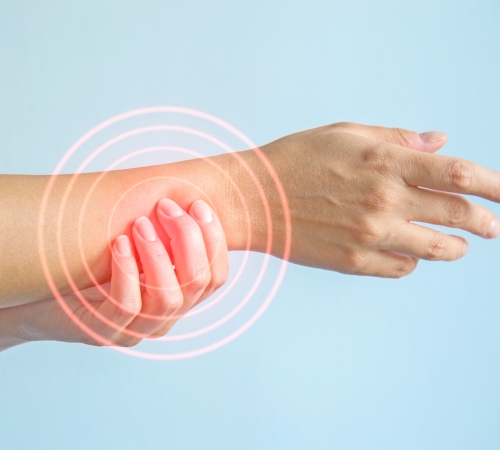
Precision Wrist Surgery in Ahmedabad for Long-Term Relief and Recovery
You use your wrist for more than you realise, until pain makes you notice every movement. When you type, drive, lift, twist, or even just hold a cup, your wrist has to work especially hard. So when pain, stiffness, or injury shows up, it doesn’t just limit your hand; it limits your life.
At Dr. Meet Mehta’s Clinic in Ahmedabad, we understand how disruptive wrist issues can be. That’s why we don’t offer one-size-fits-all answers. Whether it’s a fracture, chronic wrist pain, or recovery after trauma, our approach is precise, personal, and focused on lasting relief.
With advanced treatments like joint fusion, wrist replacement, targeted physiotherapy, and expert wrist surgery in Ahmedabad, we help you move better and live better. Book a consultation with Dr. Meet Mehta, a trusted orthopaedic wrist surgeon in Ahmedabad, and take the first step toward lasting relief and full recovery.


Dr. Meet Mehta – Offers Advanced Wrist Surgery in Ahmedabad
MBBS | MS Ortho | FASM| Arthroscopy Surgeon | Joint Preservation and Sports Medicine Specialist
Dr. Meet Mehta brings years of focused experience in treating complex wrist injuries, especially those requiring wrist fracture surgery. His approach combines precision surgical technique with smart post-op planning, ensuring patients regain full motion, grip strength, and everyday function. From clean breaks to multi-fragment fractures, he delivers results that let patients return to life, not just recovery.
He also handles advanced wrist surgery cases involving arthritis, ligament tears, and chronic pain that hasn’t responded to conservative care. Every operation is tailored to the patient, whether it’s a joint fusion, tendon repair, or wrist replacement. His goal is simple: long-term relief with minimal disruption. At Dr. Mehta’s clinic, you’re not just getting treated, you’re getting back control.
Why Choose Us for Wrist Surgery and Care?
We specialise in treating difficult wrist disorders using modern surgical techniques that promote precision and speedy recovery. From wrist fracture surgery to joint fusion and tendon repair, each case is handled by our experienced team with the goal of restoring full function and mobility.
Wrist surgery isn’t just about the procedure, it’s about long-term results. That’s why we offer thorough diagnosis, customised treatment plans, and expert follow-up care. Whether you’re dealing with an injury or chronic wrist pain, you’re choosing a centre that offers affordable wrist treatments without compromising on quality or expertise.
Wrist Anatomy Explained: What Makes It Move, Bend, and Grip
While it may seem like there’s not much to understand about your wrist being such a small part, it’s actually far more complex than it appears. The intricacy lies not just in the number of components, but in the range of movements it handles. From helping you bend your wrist to write to lifting and gripping, your wrist works like the claw of an excavator, precise and powerful. Carpals are a set of small bones that link the forearm bones to the hand. This is one of the most complicated joints in the body, with multiple ligaments, tendons, and cartilage. And when this joint is damaged, whether by trauma or arthritis, treatments like wrist joint fusion are sometimes needed to restore stability and function.
How Wrist Ligaments Work
When it comes to how the wrist functions, ligaments play the lead role. There are five different ligaments in the wrist, the collateral, volar carpal, dorsal radiocarpal, Ulnocarpal, and radiocarpal ligaments. Each one is positioned precisely to prevent unnatural bending and maintain the wrist’s stability during movement.
Tendons and Circulation in the Wrist
Apart from ligaments, the wrist also contains tendons that connect muscles to bone and enable movement. These structures work together to support the hand’s fundamental movements. Also, these elements make space for the important veins and arteries, which are important for the supply of blood to the hands.

Wrist Pain Explained: Common Causes and Key Symptoms
Most Common Causes of Wrist Pain:
- Wrist Fracture
- Arthritis
- Ligament or Tendon Tear
- Carpal Tunnel Syndrome
- Sprains or Strains
- Repetitive Stress Injury
Wrist Pain: From Sprains to Fractures
Having so many moving parts is exactly why wrist pain can come from a range of issues. If you are feeling pain but can still move your wrist, chances are it’s a sprain or strain. However, in more severe cases, like a sudden twist or impact, a ligament tear may be the reason. In such an incident, the pain can be more intense, and you may not be able to make your wrist move. In case of a fracture, not only does the pain increase, but the symptoms like inflammation and redness also show up.
Understanding Symptoms and Risk Factors of Wrist Conditions
Symptoms of Common Wrist Problems
- Persistent or sharp pain
- Swelling around the joint
- Stiffness or reduced flexibility
- Numbness or tingling sensations
- Difficulty moving the wrist or gripping objects
Risk Factors for Wrist Injuries and Pain
- Perform manual complicated tasks including typing, lifting, and assembling things.
- Play sports that strain the wrist (tennis, badminton, etc.)
- Have weak grip strength or poor wrist posture, often due to inactivity
- Have a past injury or fracture in the wrist
What Conditions Commonly Affect the Wrist
Wrist pain often results from injuries, arthritis, or nerve issues, get the right diagnosis to restore strength, movement, and comfort.

How to Prevent Wrist Pain in Daily Life
- Maintain proper hand posture while typing, writing, or using a mouse to reduce wrist strain.
- Do wrist stretches and strengthening exercises regularly to support joint stability.
- Avoid lifting heavy objects with poor technique—always align your wrist and forearm.
- Warm up your hands and wrists before any intense activity or sports.
- Avoid twisting actions and quick jerks, which can cause ligament damage.
- Never ignore wrist pain—rest and seek timely care to avoid complications.
Protect your wrists before the pain begins! For expert diagnosis and wrist surgery in Ahmedabad, book an appointment with Dr. Meet Mehta today.
Effective Treatments for Common Wrist Problems
From sprains to carpal tunnel, wrist issues need targeted care, discover treatments that relieve pain and help you move freely again.
Real Stories. Real Relief. – Testimonials
Frequently Asked Questions on Wrist Surgery and Treatment
Sports Injury and Orthopaedic Super Speciality Center
Book Consultation
Monday – Saturday 06:00 PM – 08:00 PM

Stay Updated with the Latest Blogs
 Jul 28 2025
Jul 28 2025
 Jul 28 2025
Jul 28 2025
 Jul 28 2025
Jul 28 2025

















